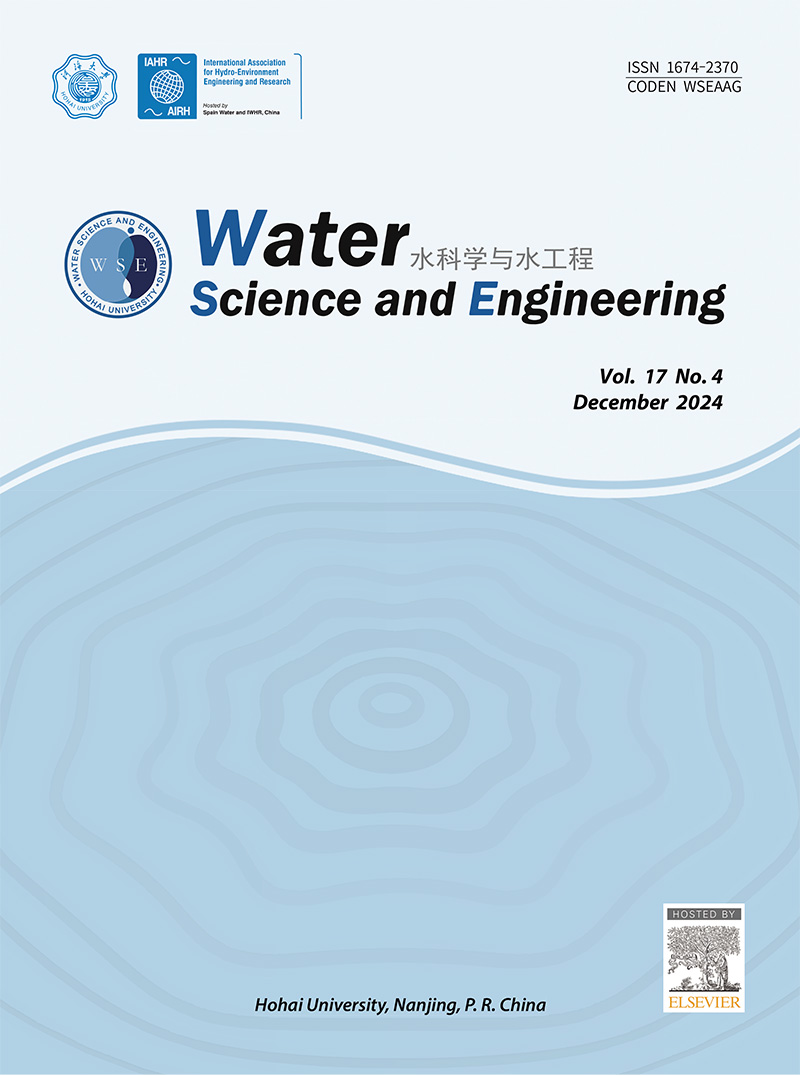Computational and experimental analysis of flow velocity and complex vortex formation around a group of bridge piers
IF 4.3
Q1 WATER RESOURCES
引用次数: 0
Abstract
In this study, the flow characteristics around a group of three piers arranged in tandem were investigated both numerically and experimentally. The simulation utilised the volume of fluid (VOF) model in conjunction with the k–ɛ method (i.e., for flow turbulence representations), implemented through the ANSYS FLUENT software, to model the free-surface flow. The simulation results were validated against laboratory measurements obtained using an acoustic Doppler velocimeter. The comparative analysis revealed discrepancies between the simulated and measured maximum velocities within the investigated flow field. However, the numerical results demonstrated a distinct vortex-induced flow pattern following the first pier and throughout the vicinity of the entire pier group, which aligned reasonably well with experimental data. In the heavily narrowed spaces between the piers, simulated velocity profiles were overestimated in the free-surface region and underestimated in the areas near the bed to the mid-stream when compared to measurements. These discrepancies diminished away from the regions with intense vortices, indicating that the employed model was capable of simulating relatively less disturbed flow turbulence. Furthermore, velocity results from both simulations and measurements were compared based on velocity distributions at three different depth ratios (0.15, 0.40, and 0.62) to assess vortex characteristic around the piers. This comparison revealed consistent results between experimental and simulated data. This research contributes to a deeper understanding of flow dynamics around complex interactive pier systems, which is critical for designing stable and sustainable hydraulic structures. Furthermore, the insights gained from this study provide valuable information for engineers aiming to develop effective strategies for controlling scour and minimizing destructive vortex effects, thereby guiding the design and maintenance of sustainable infrastructure.
桥墩群周围流速及复杂涡形成的计算与实验分析
本文采用数值和实验两种方法研究了三桥墩串列布置时桥墩周围的流动特性。仿真利用流体体积(VOF)模型结合k - ε方法(即湍流表示),通过ANSYS FLUENT软件实现,对自由表面流动进行建模。仿真结果与使用多普勒测速仪获得的实验室测量结果进行了验证。对比分析表明,在所研究的流场中,模拟的最大速度与测量的最大速度存在差异。然而,数值结果表明,在第一个桥墩之后和整个桥墩群附近存在明显的涡致流动模式,这与实验数据吻合得很好。与测量结果相比,在桥墩之间非常狭窄的空间中,模拟速度剖面在自由水面区域被高估,而在靠近河床到中游的区域被低估。这些差异在有强烈涡的区域减弱,表明所采用的模型能够模拟相对较少的扰动流动湍流。此外,基于三种不同深度比(0.15、0.40和0.62)下的速度分布,对模拟和测量的速度结果进行了比较,以评估桥墩周围的涡特性。这种比较揭示了实验数据和模拟数据之间的一致结果。该研究有助于更深入地了解复杂相互作用桥墩系统周围的流动动力学,这对于设计稳定和可持续的水工结构至关重要。此外,从本研究中获得的见解为工程师提供了有价值的信息,旨在制定有效的策略来控制冲刷和最小化破坏性涡效应,从而指导可持续基础设施的设计和维护。
本文章由计算机程序翻译,如有差异,请以英文原文为准。
求助全文
约1分钟内获得全文
求助全文
来源期刊

Water science and engineering
WATER RESOURCES-
CiteScore
6.60
自引率
5.00%
发文量
573
审稿时长
50 weeks
期刊介绍:
Water Science and Engineering journal is an international, peer-reviewed research publication covering new concepts, theories, methods, and techniques related to water issues. The journal aims to publish research that helps advance the theoretical and practical understanding of water resources, aquatic environment, aquatic ecology, and water engineering, with emphases placed on the innovation and applicability of science and technology in large-scale hydropower project construction, large river and lake regulation, inter-basin water transfer, hydroelectric energy development, ecological restoration, the development of new materials, and sustainable utilization of water resources.
 求助内容:
求助内容: 应助结果提醒方式:
应助结果提醒方式:


